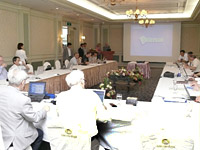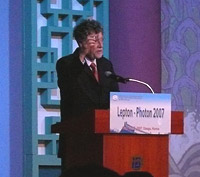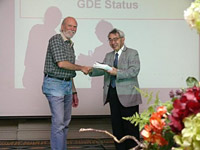 |
 |
|||||||||||||
|
|||||||||||||
|
|||||||||||||
|
As a virtual collaboration, members of the ILC community took advantage of last week’s Lepton Photon conference and held parallel meetings for the GDE Executive Committee, ILC Steering Committee (ILCSC) and the International Committee for Future Accelerators (ICFA). "We are all impressed that such good progress has been made," said ILCSC Chair Shin-Ichi Kurokawa in response to receiving the completed Reference Design Report from Barry Barish on 15 August. "We appreciate the comprehensive amount of work put into this final RDR. The ‘troika’ project managers also briefed us about the three regions moving positively toward coherent accelerator R&D programmes world-wide. In addition, we will soon be able to announce the name of a new research director who will organise the experiments.” Kurokawa explained that it is the ILCSC's role to oversee ILC R&D activities as a whole, including the accelerator and experiments. Extending the role of the Machine Advisory Committee to cover the detector R&D activities will be discussed under the next ILCSC chair, Enzo Iarocci from Frascati, who will take over at the next meeting in October. Albrecht Wagner, chair of ICFA and director of DESY, acknowledged the importance of appointing a new ILCSC chair and also commented on appointing a research director. “We reached an important agreement on establishing a research director, who will be the point of contact for the GDE in all matters concerning the experiments, and who will oversee the detector R&D efforts and letters of intent for the detectors,” he said. “This is very important to the detector community in order to match the time scale provided by the GDE." Wagner echoed Kurokawa’s comments and also foresees the role of the current Machine Advisory Committee (MAC) evolving into two bodies: one that will closely and frequently follow the activities of the GDE internally and will report to Barry Barish (the Accelerator Advisory Board), and one that will oversee the broader activities of the accelerator and the detector. "The charge of this new body will be defined together with the new ILCSC chair for the ILCSC to monitor the ILC project as a whole," he said. Wagner commented on the importance of making sure the machine and detectors fit together as one coherent design. "The uncertainty of the interaction between the machine and the detector designs will also be clarified," he said. "With the help of the research director, the way to move forward to two detector concepts, including their machine-detector interface, is now clear. It is important to move forward without cementing collaborations of detectors at their present form. For the EDR we also need the detector cost at a similar level of accuracy as for the machine. The plan for the next few years is pretty clearly defined." He explained that in order to have a complete ILC design and cost to present to funding agencies in 2010, the detector designs and costs should be known at a similarly detailed level as those of the accelerator. To do this, the present detector concepts will need to evolve into two, as specified in the RDR. “Much R&D on detector components and ideas is still incomplete at the present time and needs to be continued,” said Wagner. “ In addition, R&D on detector components alone is no longer sufficient. The ILC needs to have an integrated design including interface aspects.” As a result from the Daegu meeting, the ILCSC will send out a call for Letters of Intent for the ILC detectors. These letters will be submitted by summer 2008 and will be used to select two detector concepts. “The Letters of Intent most likely will not represent the final detectors,” said Wagner. “Just like at LEP, LHC or HERA, they serve as case studies and represent the starting point for concrete engineering designs.” He explained that the Letters of Intent will describe the resources needed in manpower for an EDR but will not commit any of them. “The Letter of Intent process will by no means preclude the possibility for an emerging collaboration to provide an alternative EDR at a later stage,” Wagner said. “It will be the task of the worldwide lab emerging during the approval phase of ILC, a period starting in 2010, to make final choices about the final two detectors.” -- Youhei Morita |
|||||||||||||
| © International Linear Collider |


